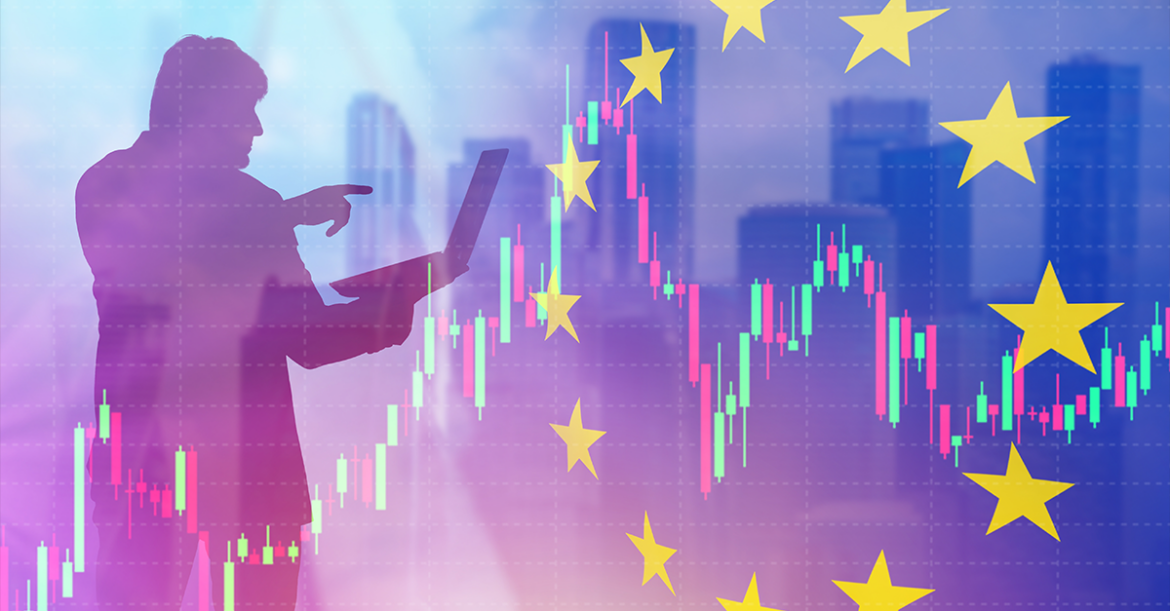Finansregulatorisk | Markedsintegrasjonspakken: EUs kapitalmarkedsunion tar ytterligere form
I dag møter finansmarkedsaktørene fremdeles ulike regler, tilsynspraksis og krav i hvert medlemsland, noe som gjør grensekryssende virksomhet mer kostbart, komplisert – og dermed mindre attraktivt for aktørene. EU ønsker å skape et genuint indre marked for finansielle tjenester, slik at man i større grad kan oppnå stordriftsfordeler som ikke oppnås i hvert medlemsland alene. EU har mange målsettinger som trenger finansiering, blant annet når det gjelder omstillingen av økonomien i retning fornybar energi og opprustningen av EU-landenes felles forsvarsevne. I tillegg er det et mål i seg selv at EUs samlede konkurransekraft skal styrkes, og da er bedre kapitaltilgang og vekstmuligheter i EU sentralt.
Nedenfor gis en oversikt over hovedproblemene som EU-kommisjonen ønsker å løse med markedsintegrasjonspakken, og noen av de regelverksendringene som foreslås.

De fire hovedutfordringene som pakken retter seg mot
EU-kommisjonen peker på fire hovedutfordringer som pakken skal bidra til å løse:
- Fragmentert infrastruktur for verdipapirhandel, avregning og oppgjør
EU-kommisjonen viser til at det i EU er mer enn 300 handelsplasser for finansielle instrumenter, 14 sentrale motparter som tilbyr clearing/avregningstjenester, og 32 verdipapirsentraler (CSD-er) som tilbyr oppgjørstjenester i EU, noe som etter EU-kommisjonens syn klart er til hinder for at man oppnår stordriftsfordeler. Til sammenligning har USA kun to verdipapirsentraler og åtte sentrale motparter.
- Avvikende regulering og tyngende krav
Finansmarkedsaktørene må i dag sette seg inn i ulike regulatoriske regimer i hvert medlemsland som både kan være avvikende og inkonsekvente, selv om kravene kan ha utspring i samme EU-direktiv (som kan gjennomføres ulikt i det ulike landene). I tillegg kan medlemslandene ha fastsatt ytterligere nasjonale krav som kommer i tillegg til EU-reguleringen, og tolkningen av EU-regelverket kan avvike fra land til land og mellom tilsynsmyndighetene.
- Fragmentert tilsyn
At nasjonale tilsynsmyndigheter tolker og praktiserer samme EU-regelverk ulikt skaper et ytterligere hinder for markedsintegrasjonen i EU, og EU-kommisjonen peker på at manglende mulighet til å sikre (eller fremtvinge) lik tilsynspraksis på EU-nivå innebærer at avvikende nasjonal praksis kan opprettholdes på tross av at det øker kostnader og undergraver målet om ensartet investorbeskyttelse. Den fragmenterte tilsynsstrukturen kan også føre til at risiko eller andre forhold ved en grensekryssende virksomhet ikke fanges opp eller håndteres godt nok av tilsynsmyndigheter.
- Regulatoriske hindringer for bruk av ny teknologi i handel, avregning og oppgjør
Avslutningsvis viser EU-kommisjonen til at regulatoriske krav er til hinder for bruk av ny og innovativ teknologi, blant annet blokkjedeteknologi (Distributed Ledger Technology – DLT) i avregnings- og oppgjørssystemer. Dagens DLT-forordning, som skulle fungere omtrent som en regulatorisk sandkasse, har blitt lite brukt grunnet en for restriktiv utforming.
Foreslåtte endringer
Markedsintegrasjonspakken består av tre lovforslag (og en meddelelse fra EU-kommisjonen):
- En hovedforordning («Master Regulation») som endrer ESMA-forordningen, EMIR (forordningen om OTC-derivater, sentrale motparter og transaksjonsregistre), MIFIR (verdipapirmarkedsforordningen), CSDR (verdipapirsentralforordningen), DLTPR (DLT-forordningen), MiCAR (kryptoeiendelsforordningen), og CBDR (forordningen om grensekryssende distribusjon av kollektive investeringsordninger, blant annet kollektive investeringsfond og alternative investeringsfond). I tillegg gjør forordningen konsekvensendringer i flere forordninger som følge av endringene i ESMA-forordningen.
- Et hoveddirektiv («Master Directive») som endrer UCITS-direktivet (om kollektive investeringsfond), AIFM-direktivet (om alternative investeringsfond) og MiFID (verdipapirmarkedsdirektivet).
- En forordning som erstatter både oppgjørsdirektivet og direktivet om finansiell sikkerhetsstillelse.
Forslagene må nå forhandles om og etter hvert vedtas av Europaparlamentet og Rådet.
Noen av endringene i hovedforordningen
Tilsyn: ESMA skal styrkes med et utvidet tilsynsmandat for sikre et mer konsistent tilsynsregime i EU. Etter forslaget skal ESMA få direkte tilsynsmyndighet over de største handelsplassene, sentrale motpartene og verdipapirsentralene og i tillegg alle kryptoeiendelstjenesteytere, og en mer koordinerende rolle i tilsynet med store kapitalforvaltere og verdipapirfond.
Handelsplasser: For å sikre et enhetlig regelverk for handelsplasser i EU, foreslås det at reglene for regulerte markeder overføres fra MiFID II (direktiv) til MiFIR (forordning). På den måten fjernes muligheten for nasjonale tilleggskrav eller for variasjoner i nasjonal gjennomføring av reglene. Overgangen fra direktiv til forordning blir også en nødvendig forutsetning for at ESMA skal kunne ta over tilsynsansvar for de største handelsplassene.
Det innføres en ny kategori av såkalte “Pan-European Market Operators” (PEMO), som tillater drift av handelsplattformer i flere medlemsland med bare én konsesjon. ESMA vil etter forslaget bli tilsynsmyndighet for PEMO-er og de største handelsplassene, samtidig som nasjonale myndigheter fremdeles skal ha noe ansvar for å overvåke markedet. En handelsplass vil anses som «significant» hvis den er viktig for EUs økonomi, eller hvis den både er av en viss størrelse og har en virksomhet med et betydelig grensekryssende element.
Inkludert i forslaget er også regler som legger bedre til rette for fordeling av ressurser og funksjoner innenfor et konsern, ved at slik fordeling innenfor et konsern ikke skal anses som utkontraktering etter MiFIR.
Kapitalforvaltning: For å forenkle muligheten for grensekryssende virksomhet, skal både kollektive investeringsfond og alternative investeringsfond underlegges en ny “passporting ved autorisasjon”-ordning. Forslaget innebærer at disse fondene skal få umiddelbar tilgang til andre deler av det indre markedet når de får konsesjon i sin hjemstat, blant annet ved hjelp av en ny plattform hos ESMA som skal samle informasjonen fra de aktuelle fondenes notifikasjoner om grensekryssende aktivitet/markedsføring.
Noen av endringene i hoveddirektivet
Alternative og kollektive investeringsfond: I direktivene om AIF’er og UCITS foreslås endringer som skal gjøre det enklere å søke om tillatelse, blant annet ved at ESMA skal lage forslag til utfyllende tekniske standarder for søknadsprosessen. En hel rekke direktivbestemmelser endres for å fjerne nasjonale valg i gjennomføringen av direktivene.
Handelsplasser: MiFID endres som nevnt for å overføre bestemmelser som gjelder drift av handelsplasser til MiFIR. I tillegg overføres bestemmelser som regulerer tillatelse til å drive en handelsplass («regulated market») til MiFIR, mens verdipapirforetak som driver multilaterale handelsfasiliteter (MHF) eller organiserte handelsfasiliteter (OHF) fortsatt vil være regulert i MiFID.
BAHR mener:
EU-kommisjonens valg om å flytte en større mengde reguleringer fra direktiver til forordninger som en del av markedsintegrasjonspakken er en naturlig utvikling på finansmarkedsområdet, hvor direktiver og flere forordninger allerede har virket en stund og hvor nasjonale regelverk dermed allerede har blitt harmonisert et godt stykke på vei. Forordninger har direkte virkning i EU uten behov for nasjonal gjennomføring, og reduserer medlemsstatenes mulighet til å supplere med nasjonale krav (såkalt gold-plating). Flytting av reglene over i forordninger (og fjerning av nasjonale valg) innebærer at man oppnår et faktisk ensartet regelverk for det indre markedet som ikke kan oppnås i direktiver. Grepet om å regulere mer i forordning gir ikke bare aktørene et likt regelverk å forholde seg til slik at det senker regulatoriske kostnader og stimulerer til mer grensekryssende aktivitet, men er også en nødvendig forutsetning for målet om å styrke ESMA som tilsynsmyndighet. Går forslaget igjennom og blir vedtatt, vil ESMA nå i større grad drive med direkte tilsyn av noen aktører og få hjemler til å vedta administrative sanksjoner. For at dette skal fungere i praksis, må ESMA kunne forholde seg til det samme regelverket uansett hvor i EU markedsaktøren er operativ.
At denne store markedsintegrasjonspakken kommer bare ni måneder etter annonseringen av SIU-strategien, gir et tydelig signal om at kapitalmarkedsintegrasjon faktisk er en politisk prioriteringssak på høyeste nivå i EU. Dette ser vi også på fremgangen i andre langvarige prosjekter som er kritiske for et fungerende felles, indre kapitalmarked, slik som en harmonisering av insolvensreglene (som kan leses om i BAHRs nyhetsbrev). At både markedsintegrasjonspakken og insolvensdirektivet nå beveger seg fremover samtidig, er ikke tilfeldig – begge er sentrale byggesteiner i den samme strategiske ambisjonen om å skape et integrert europeisk kapitalmarked som kan konkurrere med USA, Storbritannia og Asia.
For norske aktører betyr dreiningen fra direktiv til forordning på kapitalmarkedsområdet mer forutsigbarhet når reglene etter hvert innlemmes i EØS-avtalen og trer i kraft i Norge, siden de norske aktørene allerede når forordningen er vedtatt i EU vil kunne forutsi hvordan regelverket vil se ut også for dem.
Den økende bruken av forordninger kan imidlertid være utfordrende for EØS-staten Norge, hvor forordningen først må innlemmes i EØS-avtalen og deretter gjennomføres i nasjonalt regelverk (i motsetning til i EU hvor forordningen har direkte virkning i medlemslandene). Dette skaper en risiko for regulatorisk etterslep hvor EU-aktører får konkurransefortrinn gjennom tidligere tilgang til forenklinger i krav, vilkår og harmoniserte regler.









